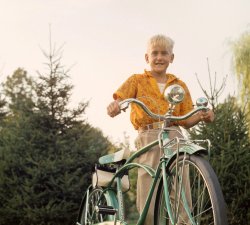
MAY CONTAIN NUTS

Search Shorpy
SHORPY ART

Framed or unframed, desk size to sofa size, printed by us in Arizona and Alabama since 2007. Explore now.
Join and Share
Ad-Free Shorpy
Shorpy is funded by you. Patreon contributors get an ad-free experience.
Learn more.

Recent comments
- Side Winder
- Air Quality?
- Sojourner Truth riot
- None were so blind(ed)
- The less famous sister
- Good ol' days?
- Rise and Fall
- Goo Goo Ga Joob
- Ticket Retention
- Not the only one
- Vagaries of War
- Killed by Amtrak
- Back to the Future
- Wanted --
- If you can't stand the light
- Centralized Traffic Control, I believe
- What's really happening
- Heckuva remote control!
- Sometimes — Things Go Bump!
- I SEE THE LIGHT
- Union Switch and Signal Company
- Get That Light Out Of My Eyes
- Eggs. Eggs. Eggs. The Egg Man is Here!
- Foreboding caption
- Famous Hollywood faces
- Not just S&P
- re: Those things in the jar
- Up In Smoke
- Medical Smoking
- Quick fix
Member Photos
The Shorpy
Print Emporium
Print Emporium
Search Shorpy
Search results -- 30 results per page
- Roll Model: 1905
- Circa 1905. "Roller skating -- young man on bicycle skates." Photoprint by Hall; George Grantham Bain Collection. View ... Charles Choubersky (1835-1891) invented the first "bicycle roller skates".
... Posted by Dave - 10/08/2019 - 12:07pm -
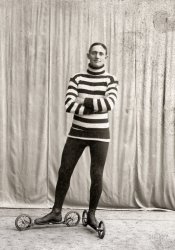
- Washington Flyer: 1921
- ... City (NYT, Jan. 22, 1914). Perhaps he found happiness as a bicycle showman later on?
"We could do that" Danny's ... Posted by Dave - 08/13/2013 - 4:09pm -
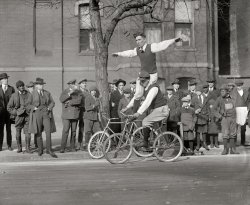
- Ice Cycle: 1941
- ...
DANGER WILL ROBINSON! Imagine trying to ride that bicycle on those icy streets.
Alternative explanation They don't open ... Steel Beauty Looks to be a late 1930's Wards Hawthorn bicycle with a New Departure two speed rear hub.
Vachonesque! Before ... Posted by Dave - 01/14/2020 - 3:15pm -
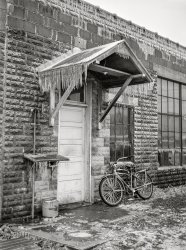
- The Flying Merkel: 1915
- ... hidden inside the forks and tubing, for a start. Not a bicycle then. I could go on about the controls and their clever use inside ... Posted by Dave - 01/09/2014 - 2:49pm -
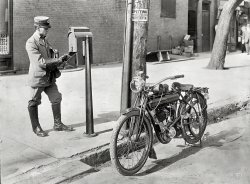
- Red Crown Gasoline: 1927
- ... Red Crown. I really, really, really wanted two for my bicycle, unfortunately I could never find a service station that had them. One ... Posted by Dave - 10/23/2014 - 12:17pm -
![Red Crown Gasoline: 1927 Northern California circa 1927. "California State Automobile Association Official Mechanical, First Aid and Towing Service Station." Offering Emergency Road Service and Red Crown Gasoline. 6½x8½ inch glass negative originally from the Wyland Stanley collection of San Francisciana. View full size.
DANCE!At Bray, a dot on the map in Siskiyou County up near the Oregon line.
Balanced gasolineNebraska, 1921.
Law & Order, Siskiyou County I believe that area is favored by the FBI for relocating newcomers into the Witness Protection Program.
Car (formerly) IDJordan. The Jordan emblem has a small arrow head pointing down on a white background, qv.
Fill 'er up? Those glass-cylinder pumps may have their charms, but it's worth considering that they made it unworkable for a motorist to say "Fill 'er up" because that would likely leave the fuel level in the glass somewhere between graduations, necessitating guesswork as to the quantity delivered -- as well as confusing matters for the next customer. And, of course, ordering fuel in even-money amounts (as opposed to by-the-gallon) was out of the question.
[Or maybe not. Below, from TheOldMotor.com - Dave]
The measuring sticks inside started out with zero gallons at the very top, where the cylinder's overflow was set, and the numbers progressed by gallons to the bottom of the glass. The customer paid for the displaced gallons by reading the measuring stick on the inside of the cylinder. The cylinder was then topped off at zero for the next customer. At closing time, fuel in the cylinder was drained back into the underground tank.
AAA / CAAHere in Canada, our affiliate with AAA is CAA, and I work for the Alberta CAA (Alberta Motor Association) formed in 1926. This is our 1926 tow truck, used in a lot of parades.
Red Crown tire valve capsIn the early 1950s Red Crown service stations gave or sold red tire valve caps in the shape of their Red Crown. I really, really, really wanted two for my bicycle, unfortunately I could never find a service station that had them. One of life’s bitter disappointments.
Red Crown Valve CapsNever too late to get some.....
Those were the daysWhen gas stations were rigged liked sailboats. I am trying, unsuccessfully, to understand the purpose of the pole/pulley/cable rig on the side of the building, which apparently opens a second story window.
[The pulley is exactly like those on the poles at the end of my mother's washlines, each of which extended from a window, one in the kitchen, one in the bedroom. -tterrace]
Thanks, tterrace, makes sense to me now.
(The Gallery, Cars, Trucks, Buses, Gas Stations, W. Stanley)](https://www.shorpy.com/files/images/SHORPY-141023-0003.thumbnail.jpg)
- The Big Shot: 1957
- ... first car I think this fellow stole Pee Wee Herman's bicycle.
But it's no Leica Found a Lordox in my local thrift store ... Posted by tterrace - 01/16/2021 - 4:16pm -
![The Big Shot: 1957 I never did get the full skinny on how it all went down that day. All I know is that it was my brother and his pal, this guy. A couple of ex-Catholic high school boys; you know the type - four years in, walk out with a fancy piece of paper, the whole nine yards. Then two years later they're back in town, cruising the mean streets, past all the usual joints - Montgomery Ward, J.C. Penney, F.W. Woolworth, Thom McAn, The Cottage Bookshop. That's right: San Rafael, California.
When it happened, it happened fast. First his pal pulls up and parks, lights himself a cig, happy as a clam, not a worry in the world. Then my brother hauls off and shoots him with his Lordox, a German 35mm job loaded with Kodak Tri-X. For years afterwards my brother keeps this pic pasted in a book or something. What a crazy guy. View full size.
Narration by Joe FridayThis could only get better by being read by Jack Webb.
Que j'en ne sais quoiIt's a shame cigarettes are so unilaterally bad for your health. As every lover of film noir knows -- they're great at helping set the mood and represent feelings not spoken.
The way I read this scene: he's counting the dough in his wallet, you can see his hands reflected in the side panel, figuring out how much he can blow on his babe. The photographer is wondering how soon the ash is gonna fall off the cig.
A mysterious caper alrightForget it, Jake, it's San Rafael.
I Feel A Song Coming OnI can't help but be reminded, by both the setting and description, of the words to "My Hometown," however, I offer a more peaceful version than the original.
"Saturday night, two cars at a light, in the backseat there was some film;
Words were passed, didn't use a flash, picture time had come ... to my hometown."
Very well, I'll see myself out ...
Which X?It looks more like Plus-X grain. Tri-X is a bit coarser.
[From the evidence locker. - tterrace]
Down those mean streets ...... a man must go who is not himself mean, who is neither tarnished nor afraid. ... Must be a complete man and a common man, yet an unusual man. He must be, to use a rather weathered phrase, a man of honor."
Evidence missing from this "Big Shot" case.Found Leidolf Lordox 24x36 German made camera!
1947 or 1948Plymouth convertible from what little I can see of the steering wheel hub.
[Buick Roadmaster seems to be the current consensus. - Dave]
A hidden truthThank you, GlenJay, for invoking the immortal lines by Raymond Chandler. I sent that entire quote to my son once. I thought it worthwhile that he should read it.
"Down these mean streets a man must go who is not himself mean, who is neither tarnished nor afraid. He is the hero; he is everything. He must be a complete man and a common man and yet an unusual man. He must be, to use a rather weathered phrase, a man of honor -- by instinct, by inevitability, without thought of it, and certainly without saying it. He must be the best man in his world and a good enough man for any world.
"He will take no man’s money dishonestly and no man’s insolence without a due and dispassionate revenge. He is a lonely man and his pride is that you will treat him as a proud man or be very sorry you ever saw him.
"The story is this man’s adventure in search of a hidden truth, and it would be no adventure if it did not happen to a man fit for adventure. If there were enough like him, the world would be a very safe place to live in, without becoming too dull to be worth living in."
Mean Streets? San Rafael ?!?Not only the year I was born, but my home town and referencing the high school I attended.
I think the meanest things down on 4th was the courthouse fire - remember looking at it the next morning on my way over the hill to St. Raphaels and it looked just like a bag of burned McDonalds fries.
After the movie came out, the biggest crime was taking 10 minutes to go a block, given all the cruisers. Mean streets?
[As noted below, "mean streets" is a continuation of the Raymond Chandler literary trope employed by tterrace in his post. - Dave]
Before getting his first carI think this fellow stole Pee Wee Herman's bicycle.
But it's no LeicaFound a Lordox in my local thrift store a few days ago.
(ShorpyBlog, Member Gallery, tterrapix)](https://www.shorpy.com/files/images/0829_SHORPY.thumbnail.jpg)
- Good Roads: 1914
- ... my house still looks like.
The interurban After the bicycle, before the automobile, for a brief time there was the interurban ... Posted by Dave - 06/15/2011 - 12:16am -
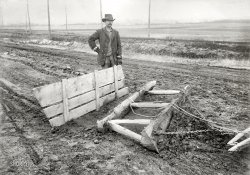
- Bustling Buffalo: 1900
- ... New York." With the Guaranty (Prudential) Building and a bicycle repair shop as neighbors. 8x10 inch dry plate glass negative, Detroit ... Posted by Dave - 07/01/2016 - 5:27pm -
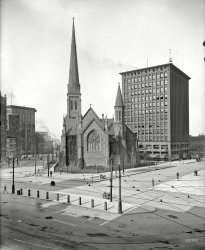
- Lincoln Park: 1905
- ... a zoo and several small-boat harbors.
I commute by bicycle in fair weather. If I take the Lincoln Park lakefront path, it adds 4 ... Posted by Dave - 08/08/2012 - 7:12pm -
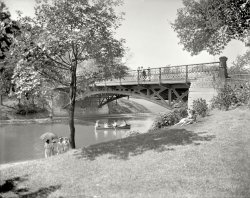
- Instant Messenger: 1913
- ... really frequent recipients of Western Union Telegrams. The bicycle's tires look to be skinny like modern day bike tires are. I guess the ... Posted by Dave - 03/28/2014 - 7:41pm -
![Instant Messenger: 1913 November 1913. Shreveport, Louisiana. "Western Union messenger No. 2, fourteen years old. Says he goes to the Red Light district all the time." Glass negative by Lewis Wickes Hine for the National Child Labor Committee. View full size.
Telegram for Miss ScarletAs pointed out in another photo's comment, Mr. L. W. Hine seems to have had a broad assortment of moral axes to grind. I'd be surprised if prostitutes were really frequent recipients of Western Union Telegrams. The bicycle's tires look to be skinny like modern day bike tires are. I guess the big balloon tires as used on the Schwinns that I remember came later.
Bike to the FutureThe cars from 1913 have hardly any resemblance to the ones made these days other than having four wheels and a body, but this bike is within a few percent of a modern coaster brake bike. Sure, a few subtle details are different, but wheels and the drive train could have been made last week.
Red LightMy question has always been with regards to this "red light district" line that Hine usually put with his messenger photos is, are the prostitutes ordering "drugs" and abusing them? Were the drug stores not under strict scrutiny like today? I imagine this to be true. Anyone else out there have any knowledge of this being the case?
[If you were in that line of work, there's one item in particular you might need plenty of that comes from a drugstore. And it's not drugs. - Dave]
SchwinnishIt might actually be a Schwinn. The circles within a circle pattern in the front sprocket is definitely a pattern that later Schwinns used.
And if you look at the shadow you can see that it is a skip-link. On modern bikes the teeth on the sprockets are right next to each other. But on this bike, there is a large gap between the teeth. This is due to the way the chain was made. On modern chains the pattern is hinge, hole for the gear tooth, hinge (ASCII art: *-*-*-). On old bikes the pattern was hinge, hinge, hole for the gear tooth, hinge, hinge (**-**-**-), so there needed to be a big gap between the teeth on the gears.
This concludes Hank's obscure bike trivia lesson.
[Click below to enlarge. - Dave]
Midnight SpecialFrom 1903 till 1917 Shreveport had legalized prostitution confined to a designated Red Light district. This was an area near Fannin street in the St. Paul Bottoms area.
The area was named after a nearby church and the low lying area. St. Paul Bottoms was recently renamed Ledbetter Heights in honor of blues singer Huddie Ledbetter, Lead Belly, who honed his style playing the Bottoms' brothels, saloons, and dance halls. Midnight Special is one of his most famous songs. Maybe Messenger #2 heard Lead Belly play Fannin Street! Selected Lyrics:
My mama told me
My sister too
Said, 'The Shreveport women, son,
Will be the death of you'
Said to my mama,
'Mama, you don't know
If the Fannin Street women gonna kill me
Well, you might as well let me go'
I got a woman
Lives back of the jail
Makes an honest livin'
By the wigglin' of her tail
Even after the optimistic name change the area is still referred to as The Bottoms by many locals and remains one of the poorest downtrodden sections of town.
(The Gallery, Bicycles, Kids, Lewis Hine)](https://www.shorpy.com/files/images/SHORPY_05549u1_0.thumbnail.jpg)
- Embraceable Utica: 1910
- ... To the left of South Streetcar 65, that of a man on a bicycle.
Note: Man in the Barber Chair & Barber. Also Block & ... Posted by Dave - 08/21/2012 - 11:18am -
![Embraceable Utica: 1910 Utica, New York, circa 1910. "Genesee and Bleecker streets." Points of interest include the City Candy Kitchen, City National Bank, a streetcar control tower and the Commercial Travelers building seen in an earlier post. View full size.
Busy Corner Drug StoreMedicine bottles from Sullivan & Slauson Busy Corner Drug Store have become collectables. Ricks Bottle Room has more info and photos.
Maybe someone else sees it but I'm having trouble figuring out what is Embraceable about the photo.
American Druggist and Pharmaceutical Record, 1901.
Buffalo Notes
The old drug establishment at the corner of Genesee and Lafayette streets. Utica, for a number of years known as McMillan's drug store, has been secured by Daniel J. Sullivan and John G. Slauson, and will be run under the firm name of Sullivan & Slauson. The members of the new firm are well known and popular. Mr. Sullivan was for years employed by John H. Sheehan & Co., and later by W. A. Teachout, but recently had charge of the prescription department of Crazier W. Hurlburt's drug store. He is a graduate of the New York College of Pharmacy. Mr. Slanson was for nine years employed by Howarth & Ballard as a prescription clerk. It is the intention of the new firm to remodel the store.
Lyrical title It could be associated with a Holiday.
Parked at BusycornerIt looks to me as if "Busy Corner" is a compound word on the sign (not positive because a pole obscures the "C" of "corner"). If so, a neat turn that gives the sign even more character.
I noticed the little carriage parked ahead of the car in this transitional period from horse-and-buggy to internal combustion. I like the fastidious lady sitting in the back seat so she doesn't have to dirty her petticoats clambering over the wheel, while her husband sits in front ready to drive whenever the other passenger comes out of the store. I assume he's her husband and not a hired chauffeur because he isn't uniformed, but maybe that's not typical of the period.
This is an upper class lady, I think, because the horses are a matched pair (same color and size). Is she reading a book to pass the time, or just looking for something in her purse?
Take me awayWhat a fabulous photo. I love seeing the women and children out on the street enjoying life.
BusyThe lady in the carriage (under the barber shop windows) seems very focused on something in her hands. I wonder: could she be downloading Scott Joplin's "Solace" to her iPhone?
Man on the streetThe man at the far right side of the picture is asking himself the age old question "Does my breath stink?"
ObservationsWith the greatest respect I find I have to disagree with other posters. On closer inspection it would seem that the gentleman in front is wearing a uniform and therefore likely to be the chauffeur to the lady in the carriage. I would like to suggest that we are waiting for "Sir" who must be in the bank. It will also become obvious that madam is actually checking her text messages (no earphone leads)! I can't recall seeing the "screens" hanging round horses like this before. Dare I suggest that they maybe something of a "modesty blanket" that madame demands around her beautiful (and expensive) pair.
[That's fly netting on the horse. Seen here in a number of posts. - Dave]
Duly NotedThe Lady in the carriage is sitting behind her driver, she is not doing anything other than keeping the sun out of her eyes, hands folded upon her purse, possibly napping.
Man with hand up on sidewalk, not smelling his breath, as the Lady to his right has placed her hand over part of her face, possibly neither wanting their photograph taken. Before Facial Recognition.
Below the sign City Candy Kitchen appears to be a group of Girls with umbrellas and hats, possibly a school field trip. To the left of South Streetcar 65, that of a man on a bicycle.
Note: Man in the Barber Chair & Barber. Also Block & Tackle rig, big hook hanging from roof of the Bank.
(The Gallery, DPC, Streetcars, Utica)](https://www.shorpy.com/files/images/4a19572a.thumbnail.jpg)
- The Metropole: 1915
- ... and original condition of many of the houses, I rented a bicycle and rode up and down the back alleys in search of antiquated electrical ... Posted by Dave - 07/08/2018 - 8:20pm -
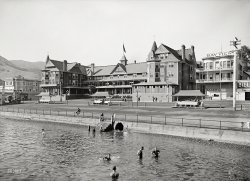
- Corner Office: 1909
- ... That is a 1906 Cadillac runabout parked just behind the bicycle. Selling for $750 when new, it was a high quality and fairly ... Posted by Dave - 08/13/2013 - 4:03pm -
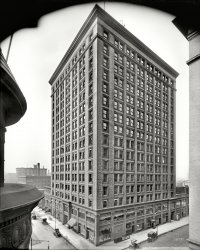
- Tower of Landin'
- ...
Airport access As teenagers, a friend and I used to bicycle from our homes in Flushing, NY the 8 or 10 miles to Idlewild Airport - ... Posted by Dave - 11/13/2013 - 12:54pm -
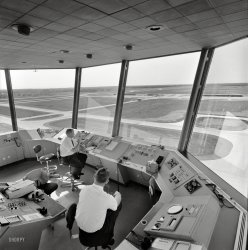
- Crusty Schmidt: 1917
- ... Since gas was rationed tightly, he sold our car and rode a bicycle to work until the end of the war. He stayed with the bakery for a ... Posted by Dave - 08/26/2012 - 11:43am -
![Crusty Schmidt: 1917 "Camp Meade, Maryland, 1917." Harris & Ewing glass negative. View full size.
Mmm Crusty breadI'm guessing that "Crusty" is a good thing, back then anyway. BTW, put some air in those tires, will ya!
Look at those tires!Dear Lord, look at the tire on the truck. It appears to be solid rubber.
This means a bone-shaking jolt for the driver every time he runs over so much as a nickel.
Worse: the wheels will frequently be out of contact with the pavement, making skids far more likely than with pneumatic tires.
Having to lug 100-pound crates around may be the least of our nattily-dressed driver's issues.
Truck's wheelsI'm fascinated by the fact that the truck appears to have no tires. I haven't seen many (if any) trucks from this period. It must have been a nightmare to drive.
[The truck has solid rubber tires. - Dave]
Camp to FortI spent the last 6 months of my Army service during the Vietnam War at what was had been upgraded to "Fort" Meade, and was discharged in July 1967. At the time I was living with my wife in Arlington, Va., and commuted daily 40 miles each direction in my Renault Dauphine to make early formation.
Speed , not comfort I can't imagine the spine shattering ride on those tires.
Civilian breadCivilian Bread being delivered to the cook? When I was in during the Korean mess, all of our bread was made at the Fort Jackson Army bakery and always seemed to be day old. Got pretty used to it until one happy day the camp bakery broke down and they supplied us with "civilian" bread. Man, that was real eating and I have never forgotten that day. Yummmm!
Also, look at all those sacks of taters that some poor KPs are going to have to peel though I was never assigned to that detail. Fort Jackson (SC) used coal fired ranges while I was there that had to be cleaned once a week by rubbing them internally with brickbats so they would pass Saturday inspection.
Schmidt'sThe Schmidt Bakery is still around, though they no longer hawk "crusty bread". Started in 1886 by German immigrants, it is still family owned (run by their great-grandson) and has bakeries in Baltimore and Fullerton.
Schmidt's potato bread is, by the way, outstanding. Yum.
Bread for the troopsBread for soldiers from civilian sources is, or was not unusual. My father was an employee of Colonial Bakery in Fort Smith, Arkansas during WWII. The bakery provided bread for nearby Camp (later Fort, now closed) Chaffee. The draft board (or other authority) declared his job as essential to the war effort. As a result, he could not quit his job, the bakery could not fire him, he could not be drafted, nor could he volunteer for the Armed Forces. He was to bake bread for the duration of the war. Since gas was rationed tightly, he sold our car and rode a bicycle to work until the end of the war. He stayed with the bakery for a 49-year career.
Lift That BaleHere we have another guy in a necktie doing some heavy lifting. That crate looks like it's made of wood. His life could have been easier with some sort of cardboard or masonite container.
(The Gallery, Cars, Trucks, Buses, Harris + Ewing, WWI)](https://www.shorpy.com/files/images/09647a.thumbnail.jpg)
- To Good Hope Hills: 1924
- ... you noticed all the extra hats the kids in front of the bicycle have? Are they recruiting more boys to go to Good Hope Hills? Or were ... Posted by Dave - 04/28/2014 - 11:58am -
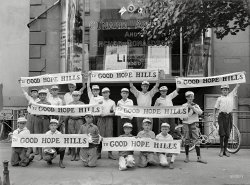
- Swing Time: 1955
- ... a double dip and a use-pitted dirt landing. We also made bicycle pilgrimages to the Jacksonwald elementary school which featured a ... Posted by Dave - 05/24/2013 - 5:05pm -
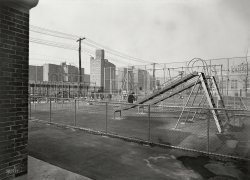
- The Barber of Poughkeepsie: 1904
- ... didn't need a chain and lock that weighed more than your bicycle, when leaving it unattended.
(The Gallery, Bicycles, DPC, Stores & ... Posted by Dave - 07/11/2014 - 10:15am -
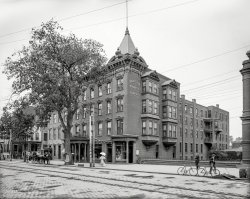
- Department of Admissions: 1904
- ... The lawn through the gate looks to be covered with bicycle tracks.
[Their pattern seems more consistent with carriage ... Posted by Dave - 06/26/2015 - 10:21am -
![Department of Admissions: 1904 Poughkeepsie, N.Y., circa 1904. "The entrance, Vassar College." Note the sign. 8x10 inch glass transparency, Detroit Publishing Company. View full size.
Welcome to Vassar!Velocipedes Verboten.
Wow -- Cheesy '60s HorrorI hear Don Knotts playing the organ somewhere.
Sign notwithstandingThe lawn through the gate looks to be covered with bicycle tracks.
[Their pattern seems more consistent with carriage tracks. -tterrace]
Address1313 Mockingbird Lane, right?
Purity and Wisdom (Vassar motto)Since I have neither, I've never been there.
PostcardColorized postcard.
Replaced 1913The gate house, designed by James Renwick, Jr., was replaced in 1913 by Taylor Hall. Evidently the gatekeeper and his family lived in the south tower and the north tower was occupied originally by the college engineer, appropriately named Mr. Gatehouse.
(The Gallery, Bicycles, DPC, Education, Schools)](https://www.shorpy.com/files/images/SHORPY-4a29983a.thumbnail.jpg)
- Sand Dancers: 1922
- ... we wore out our arms inflating those things with a scrawny bicycle pump.
Digging those dresses The (swim?) dresses with the ... Posted by Dave - 09/11/2011 - 10:49am -
![Sand Dancers: 1922 July 6, 1922. "People dancing on beach." Pavilion at the Potomac bathing beach in Washington. View full size. National Photo Company Collection glass negative.
The FellowThird from the left (with his arms folded across his chest) appears to be the same person from "When We Were Young", also standing on the left side of the photo (note the logo on the bathing suit).
[Same guy, but the swimsuits are different. - Dave]
TuberPoor kid with the innertube would have had a tough time hanging onto that skinny thing. My dad was in heavy construction, and we would occasionally be gifted with a huge truck tire tube which was almost too big to climb up on while in the water. Plus, we wore out our arms inflating those things with a scrawny bicycle pump.
Digging those dressesThe (swim?) dresses with the stripes that those girls have one (like the girl far right next to innertube guy) are too cool.
Let's do the BalboaThese folks look to be doing the "Balboa," a dance that started in the mid-teens in SoCal. Not much is known about the dance, but likely stems from the same roots as Lindy Hop, Collegiate Shag, and other forms of swing dance. Bal was often done on beaches as opposed to other swing dances because it is more of a shuffle step.
Oh, and there was the small matter of it typically being a full-body contact dance... most of the lead was in the body connection. Although, in these bathing suits, a full-body lead would be... erm... a bit interesting for the guys, to say the least.
Balboa is alive and well.Balboa is being danced all over the place; it's a great dance for super-fast tempos like Dixieland. I've gone to swing dances in Seattle, L.A, Chicago and Miami, and have seen Balboa in all those fine cities.
(The Gallery, D.C., Natl Photo, Sports, Swimming)](https://www.shorpy.com/files/images/06641u.thumbnail.jpg)
- Look, Ma: 1921
- ... times the size of the rear sprocket. However, this bicycle is a very specialized one, designed for doing trick riding. Having ... Posted by Dave - 08/13/2013 - 4:06pm -
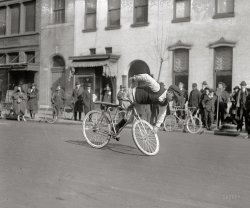
- City of Mackinac: 1905
- ... but wonder if the boy heading at breakneck speed on his bicycle towards the freight office succeeded in avoiding running over the two ... Posted by Dave - 07/22/2019 - 3:45pm -
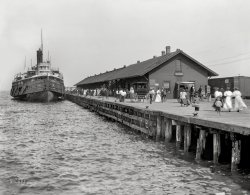
- Papers Aplenty: 1918
- ... any of them, now prized antiques. I also see a vintage bicycle and sewing machine peeking out of the stacks to the right. But all went ... Posted by Dave - 07/10/2011 - 1:06pm -
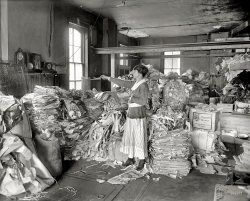
- A Boy and His Dogs: 1928
- ... a bit wobbly with that, shall we say, less than straight bicycle wheel. I can remember enduring such things when I was young also. ... Posted by Dave - 11/01/2013 - 1:11pm -
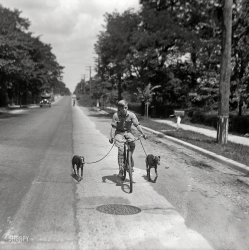
- Lever Driven: 1867
- ... of the historic development of the cycle to the modern bicycle as we know it today. View full size.
(ShorpyBlog, Member ... Posted by LORNE-SHIELDS - 04/27/2022 - 2:48pm -
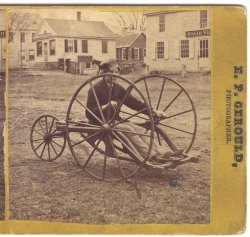
- Percy Neville: 1913
- ... before WWI (possibly later too). There are a lot of bicycle photos on Shorpy showing this.
I love this photo.
(The ... Posted by Dave - 08/13/2013 - 4:11pm -
![Percy Neville: 1913 November 1913. Shreveport, Louisiana. "Percy Neville, 11 years old. Messenger boy #6 for Mackay Telegraph Company. He has been messenger for different companies for four years. Goes to the Reservation [red light district] every day." View full size. Photograph and caption by Lewis Wickes Hine.
HandlebarsInteresting; I don't believe I've seen exactly this "gull-wing" style before. These mustache bars are a modern recreation of an early 20th-century style.
Denny Gill
Chugiak, Alaska
Urgent businessThe standard comment about these messenger boys is, "Has been to the Reservation." Can someone please tell me who is sending telegrams to cathouses and why?
[If the cathouse doesn't have a telephone, you send a telegram by messenger. - Dave]
HandlebarsThis style handlebar is actually hinged in the center so you can adjust the angle.
When you see bars dropped down really low, the bikes were called "scorchers" -- really popular before WWI (possibly later too). There are a lot of bicycle photos on Shorpy showing this.
I love this photo.
(The Gallery, Bicycles, Kids, Lewis Hine)](https://www.shorpy.com/files/images/05548u.thumbnail.jpg)
- The Bossy Lamppost: 1943
- ...
I wonder, too, how I survived my own childhood. No bicycle helmets, roaming around on my own, walking to school unattended (even ... Posted by Dave - 01/31/2013 - 4:18am -
![The Bossy Lamppost: 1943 New York, May-June 1943. "Many accidents are attributed to unpatrolled intersections in Harlem. Here schoolchildren are allowed to run across busy intersections unescorted." Photo by Gordon Parks for the OWI. View full size.
Ashcan Alley nearby?The Ashcan Alley post had a can that seemed to have "4ST" painted on it. Given this was in Harlem, I had wondered if that meant 134th Street.
Since the Bossy Lamppost shows Gordon Parks was shooting on 134th, I bet the Ashcan Alley is nearby. Could not find it, though, on Google Street View.
[134th is the cross street. As noted below by timeandagain, we are looking north up Seventh Avenue. - Dave]
7th Ave. todayThis view is looking north on Seventh Avenue (now Adam Clayton Powell Jr. Boulevard) from W. 134th Street.
View Larger Map
Quiet SchoolAs a 29 year teacher, I don't think I've ever been to a Quiet School.
A historic spot for a crossingOne street up, on the left, is The Big Apple, a bar and club opened in 1934, it was frequented by musicians and entertainers. Bessie Smith was there several times. Opposite it was a more famous club, Smalls' Paradise, which was eventually bought by Wilt Chamberlain. In the 1960s, it was openly a gay bar, but it had almost been that since the 1930,when it was a showbiz hangout.
The upside-down apple sign was a landmark of sorts. Someone rescued it and put it up on eBay, but too much money was asked. It is rumored to be in someone's Florida closet now.
Season ?With all the leafless trees and heavy clothing it's not likely a May-June scene.
Traffic?What traffic?
Looks kind of quiet on the road. So the kids probaly had a viable excuse. And the whole lot looks rather orderly. So I wonder whether there is not somebody "qualified" in the lead, masked by the lamppost, even there is nobody bringing up the rear.
I wonder, too, how I survived my own childhood. No bicycle helmets, roaming around on my own, walking to school unattended (even to pre-school), and so on.
(The Gallery, Gordon Parks, Kids, NYC)](https://www.shorpy.com/files/images/SHORPY_8d28510a.thumbnail.jpg)
- Look Out World, Here I Come
- Washington, D.C., 1921. " Times boy and bicycle." Winner of a Mead Ranger bike by virtue of selling 30 newspaper ... Posted by Dave - 08/13/2013 - 3:45pm -
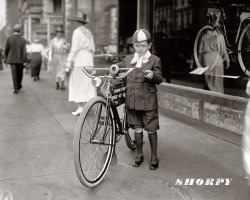
- Thanks Sherman?
- ... on the gasometer structure in back).
As with the bicycle in the poster, gasometers weren't widely used until decades after the ... Posted by Loneliness - 09/09/2011 - 10:18pm -
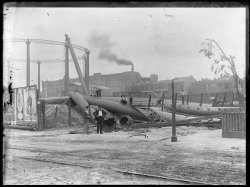
- Rollfast Redux: 1959
- ... coal mining town I grew up in in the 50's and 60's.
A bicycle that nice would get you beat up everyday. Nobody had that kind money to ... Posted by jckazoo - 02/04/2018 - 11:11am -
